Diversity of Cropping Patterns and Factors Affecting Homegarden Cultivation in Kiboguwa on the Eastern Slopes of the Uluguru Mountains in Tanzania
Abstract
1. Introduction
2. Materials and Methods
2.1. Study Area
2.2. Participatory Survey
2.3. Measurement of Cropping Patterns
2.4. Measurements of Temperature at Different Elevations
2.5. Collection of Historical Information of Homegarden Crops
2.6. Questionnaire Survey
3. Results
3.1. Diversity of the Cropping Patterns in the Village Homegardens
3.2. Crop Grouping Based on Their Heights
3.3. Distribution of Households According to Cropping Patterns
3.4. Differences in Temperature at Each Elevation
3.5. Characteristics of the Crops at Different Elevations
3.6. Variations in the Cropping Patterns of Households Distributed at Elevations of 900 m and Below
3.7. Other Cropping Patterns
3.8. Historical Changes of the Homegarden Crops: Introduction and Spread of Tree Crops
3.9. Effect of Ujaama on the Expansion of Tree Crops in Homegardens
3.10. Effects of the Ujamaa Policy on the Land Outside the Homegardens
3.11. Changes of the Tree Crop Cultivation
3.12. Characteristics of the Household Structures on Cropping Patterns
4. Discussion
5. Conclusions
Supplementary Materials
Author Contributions
Funding
Conflicts of Interest
References
- Nair, P.K.R.; Kumar, B.M. Introduction. In Tropical Homegardens: A Time-Tested Example of Sustainable Agroforestry; Kumar, B.M., Nair, P.K.R., Eds.; Springer: Dordrecht, The Netherlands, 2006; pp. 1–12. [Google Scholar]
- Peyre, A.; Guidal, A.; Wiersum, K.F.; Bongers, F. Dynamics of homegarden structure and functions in Kerala, India. Agrofor. Syst. 2006, 66, 101–115. [Google Scholar] [CrossRef]
- Wiersum, K.F. Diversity and change in homegarden cultivation in Indonesia. In Tropical Homegardens: A Time-Tested Example of Sustainable Agroforestry; Kumar, B.M., Nair, P.K.R., Eds.; Springer Science: Dordrecht, The Netherlands, 2006; Volume 3. [Google Scholar]
- Galhena, D.H.; Freed, R.; Maredia, K.M. Home gardens: A promising approach to enhance household food security and wellbeing. Agric. Food Secur. 2013, 2, 8. [Google Scholar] [CrossRef]
- Abebe, T.; Wiersum, K.F.; Bongers, F. Spatial and temporal variation in crop diversity in agroforestry homegardens of southern Ethiopia. Agrofor. Syst. 2010, 78, 309–322. [Google Scholar] [CrossRef]
- Soda, O. The History of Modern Agricultural Thought—For Agriculture in the 21st Century; Iwanami Shyoten: Tokyo, Japan, 2013; p. 236. (In Japanese) [Google Scholar]
- Suzuki, S. Agricultural Extension in Developing Countries and Its Evaluation; Tokyo Agricultural University Publishing Association: Tokyo, Japan, 2010; pp. 230–247. (In Japanese) [Google Scholar]
- Tsuruta, T. Historical consideration of agriculture/pastoral complexes in Western African semi arid areas; case examples of the Tanzania ground strip and its surroundings. Bull. Fac. Agric. Kinki Univ. 2011, 44, 97–114. (In Japanese) [Google Scholar]
- Zimpita, T.; Biggs, C.; Faber, M. Gardening Practices in a Rural Village in South Africa 10 Years after Completion of a Home Garden Project. Food Nutr. Bull. 2015, 36, 33–42. [Google Scholar] [CrossRef] [PubMed]
- Assefa, T.T.; Jha, M.K.; Reyes, M.R.; Schimmel, K.; Tilahun, S.A. Commercial Home Gardens under Conservation Agriculture and Drip Irrigation for Small Holder Farming in sub-Saharan Africa. In Proceedings of the ASABE Annual International Meeting, Spokane, WA, USA, 16–19 July 2017. [Google Scholar]
- Kim, D.G.; Terefe, B.; Girma, S.; Kedir, H.; Morkie, N.; Woldie, T.M. Conversion of home garden agroforestry to crop fields reduced soil carbon and nitrogen stocks in Southern Ethiopia. Agrofor. Syst. 2017, 90, 251–264. [Google Scholar] [CrossRef]
- Gbedomon, R.C.; Salako, V.K.; Fandohan, A.B.; Idohou, A.F.R.; Kakaї, R.G.; Assogbadjo, A.E. Functional diversity of home gardens and their agrobiodiversity conservation benefits in Benin, West Africa. J. Ethnobiol. Ethnomed. 2017, 13, 66. [Google Scholar] [CrossRef] [PubMed]
- Amberber, M.; Argaw, M.; Asfaw, Z. The role of homegardens for in situ conservation of plant biodiversity in Holeta Town, Oromia National Regional State, Ethiopia. Int. J. Biodivers. Conserv. 2014, 6, 8–16. [Google Scholar]
- Abebe, T. Diversity in Homegarden Agroforestry Systems of Southern Ethiopia. Ph.D. Thesis, Wageningen University, Wageningen, The Netherlands, 2005. [Google Scholar]
- Maruo, S. People who live with bananas: A case study of the village of the Haya in Western Tanzania. In African Farmer’s World—Transformation and Its Indigenous; Kakeya, M., Ed.; Kyoto University Press: Kyoto, Japan, 2002; pp. 51–90. (In Japanese) [Google Scholar]
- Reyes, T.; Quiroz, R.; Msikula, S. Socio-economic comparison between traditional and improved cultivation methods in Agroforestry systems, East Usambara Mountains, Tanzania. Environ. Manag. 2005, 36, 682–690. [Google Scholar] [CrossRef] [PubMed]
- Rugalema, G.H.; Okting’Ati, A.; Johnsen, F.H. The homegarden agroforestry system of Bukoba district, North-Western Tanzania. 1. Farming system analysis. Agrofor. Syst. 1994, 26, 53–64. [Google Scholar] [CrossRef]
- Soini, E. Land use change patterns and livelihood dynamics on the slopes of Mt. Kilimanjaro, Tanzania. Agrofor. Syst. 2005, 85, 306–323. [Google Scholar] [CrossRef]
- Masawe, J.L. Farming system and agricultural production among small farmers in the Uluguru Mountain area, Morogoro region, Tanzania. Afr. Study Monogr. 1992, 13, 171–183. [Google Scholar]
- Yamane, Y.; Kularatne, J.; Ito, K. Agricultural production and food consumption of mountain farmers in Tanzania: A case study of Kiboguwa village in Uruguru Mountains. Agric. Food Secur. 2018, 7, 54. [Google Scholar] [CrossRef]
- Young, R.; Fosbrooke, H. Land and Politics among the Luguru of Tanganyika; Routledge & Kegan Paul: London, UK, 1960. [Google Scholar]
- Beidelman, T.O. The Matrilineal Peoples of Eastern Tanzania; International African Institute: London, UK, 1967. [Google Scholar]
- Yamane, Y.; Higuchi, H. Subsistence strategy of small farmers observed in planting of commercial crops in the homestead of the mountains of rural Tanzania: A case study of Kiboguwa Village on the Eastern Slopes of Uluguru Mountain in Tanzania. J. Agric. Dev. Stud. 2016, 27, 1–12. (In Japanese) [Google Scholar]
- Maxwell, J. Qualitative Research Design: An Interactive Approach; Applied Social Research Methods; SAGE Publications: London, UK, 2005; pp. 87–121. [Google Scholar]
- Krebs, C.J. Ecological Methodology, 2nd ed.; Group Limited Wesley, Longman: Harlow, UK, 1998. [Google Scholar]
- Rwezimula, F.; Tanaka, U.; Ikeno, J. Agro-ecological characteristics and inherent roles of indigenous farming systems on the eastern slopes of northern Uluguru Mountains, Tanzania. J. Agric. Dev. Stud. 2010, 20, 65–71. [Google Scholar]
- Arcland, J.D. East African Crops; Longman Group Limited: Hong Kong, China, 1980. [Google Scholar]
- Odhiambo, E.S.A.; Ouso, T.I.; Williams, J.F.M. The Inter Years: Tanganika, Zanzibar and Rwanda-Urundi Pages: A History of East Africa; Longman Group Limited: Guangdong, China, 2006. [Google Scholar]
- Ponte, S. Trapped in decline? Reassessing agrarian change and economic diversification on the Uluguru Mountains, Tanzania. J. Mod. Afr. Stud. 2001, 39, 81–100. [Google Scholar] [CrossRef]
- Pretty, J. Agri-Culture-Reconnecting, People, Lands and Nature; Earthscan: London, UK, 2002. [Google Scholar]
- Ravindran, P.N.; Nirmal-Babu, K.; Shylaja, M. Cinnamon and Cassia ‘The Genus Cinnamomum’. In Medicinal and Aromatic Plants Industrial Profiles; CRC Press: Boca Raton, FL, USA, 2004. [Google Scholar]
- Galluzzi, G.; Eyzaguirre, P.; Negri, V. Home gardens: Neglected hotspots of agro-biodiversity and cultural diversity. Biodivers. Conserv. 2010, 19, 3635–3654. [Google Scholar] [CrossRef]
- Rao, M.R.; Rao, B.R.R. Medical plants in tropical homegardens. In Tropical Homegardens: A Time-Tested Example of Sustainable Agroforestry; Kumar, B.M., Nair, P.K.R., Eds.; Springer: Dordrecht, The Netherlands, 2006; pp. 205–232. [Google Scholar]
- Angelsen, A.; Kaimowitz, D. Rethinking the causes of deforestation: Lessons from economic models. World Bank Res Obs. 1999, 14, 73–98. [Google Scholar] [CrossRef] [PubMed]
- Nishimura, Y. Agriculture Rural development and technology development Technology transfer. In Introduction to International Development Studies: Interdisciplinary Construction of Development Studies; Otubo, S., Kimura, H., Ito, S., Eds.; Kusakasybo Limited: Saitama, Japan, 2009; pp. 334–343. [Google Scholar]
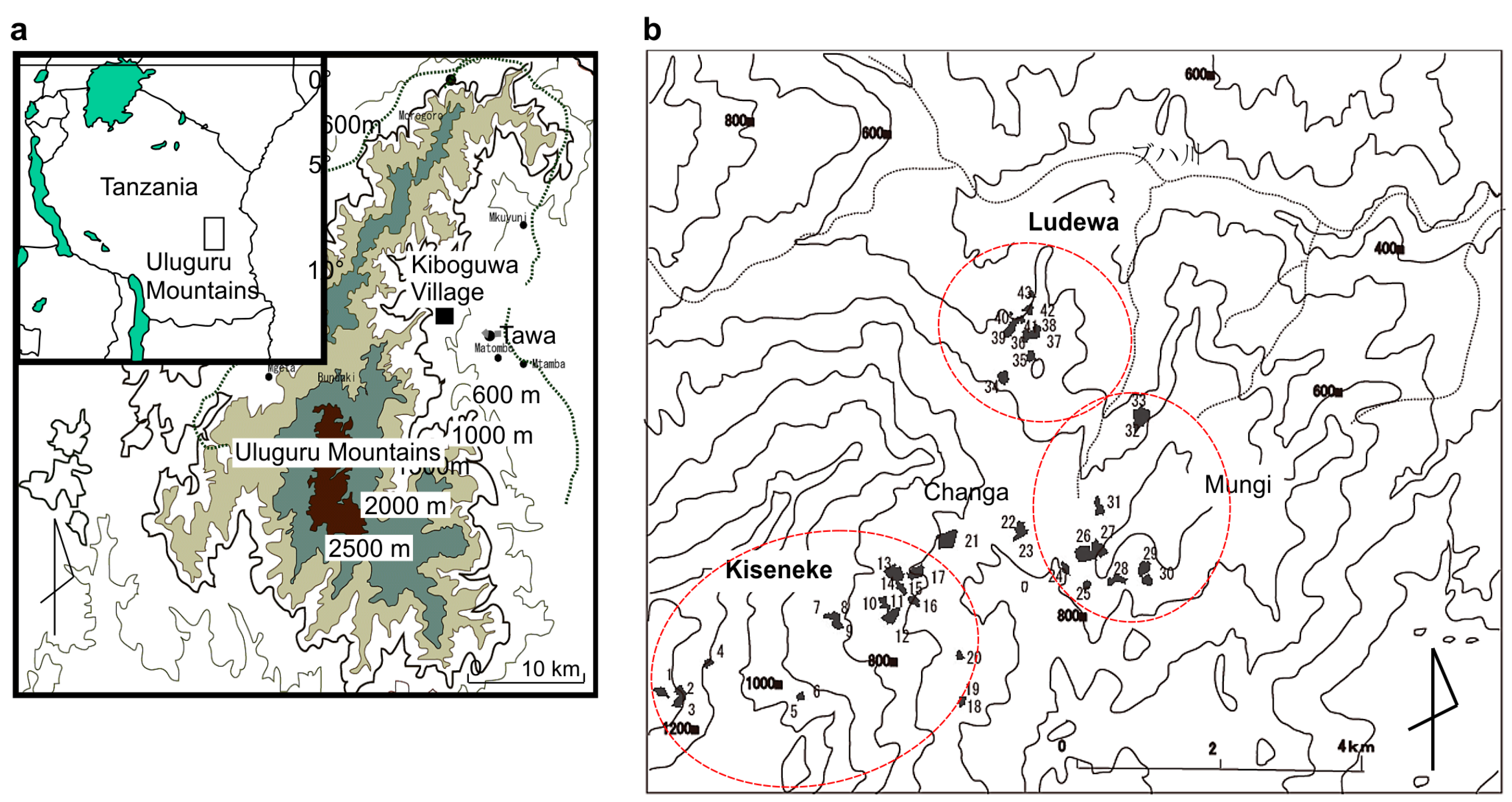
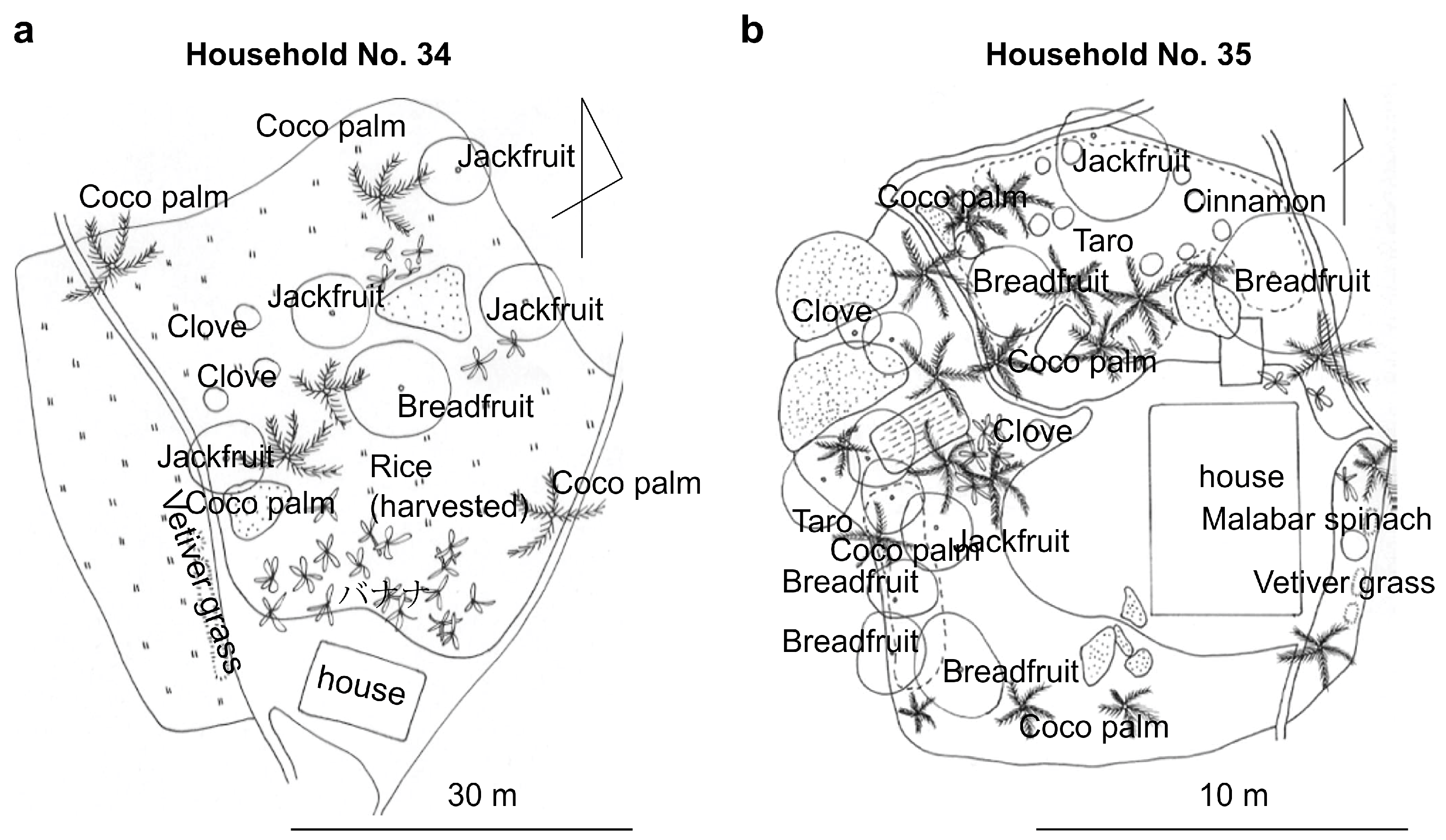
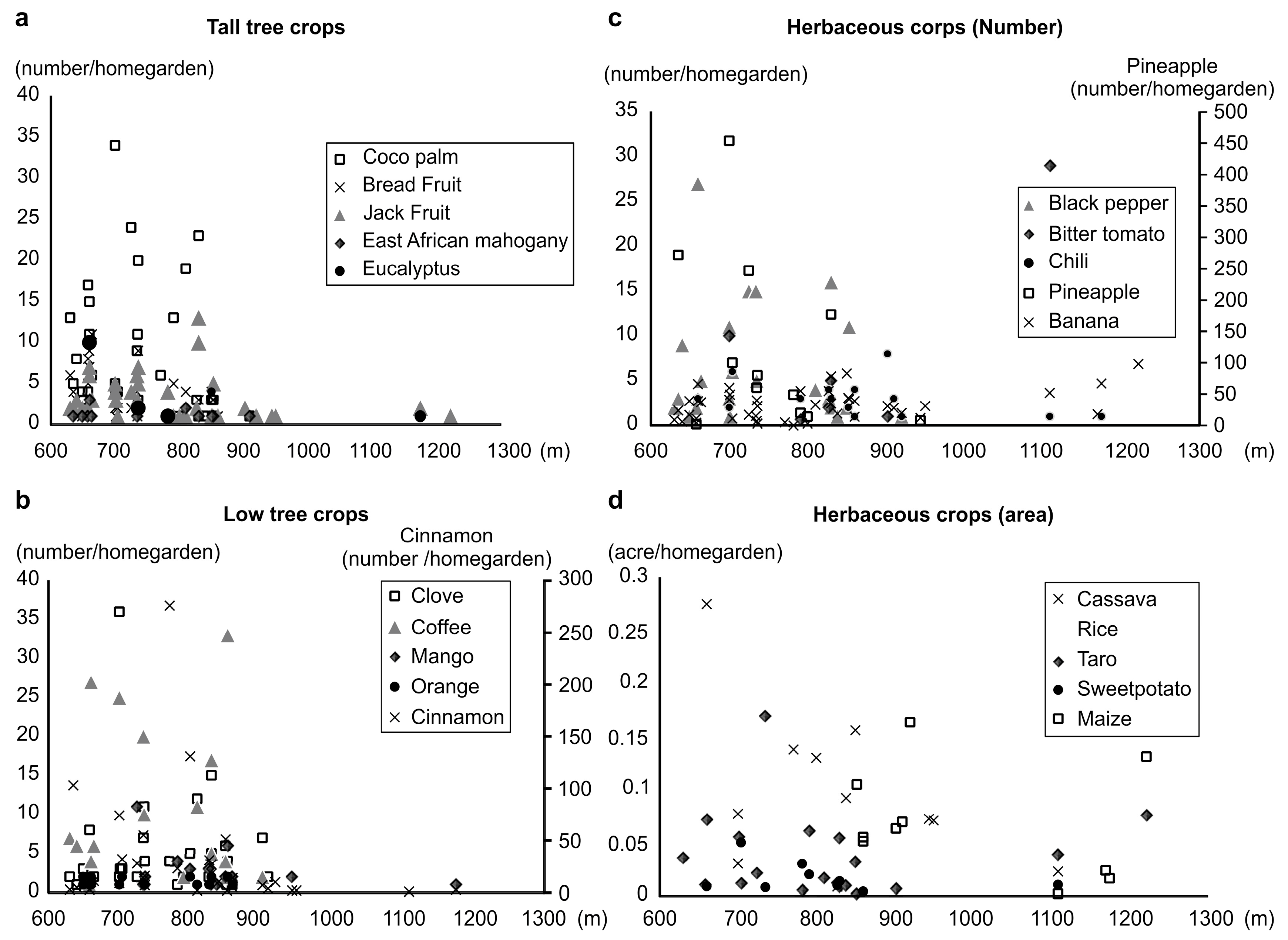
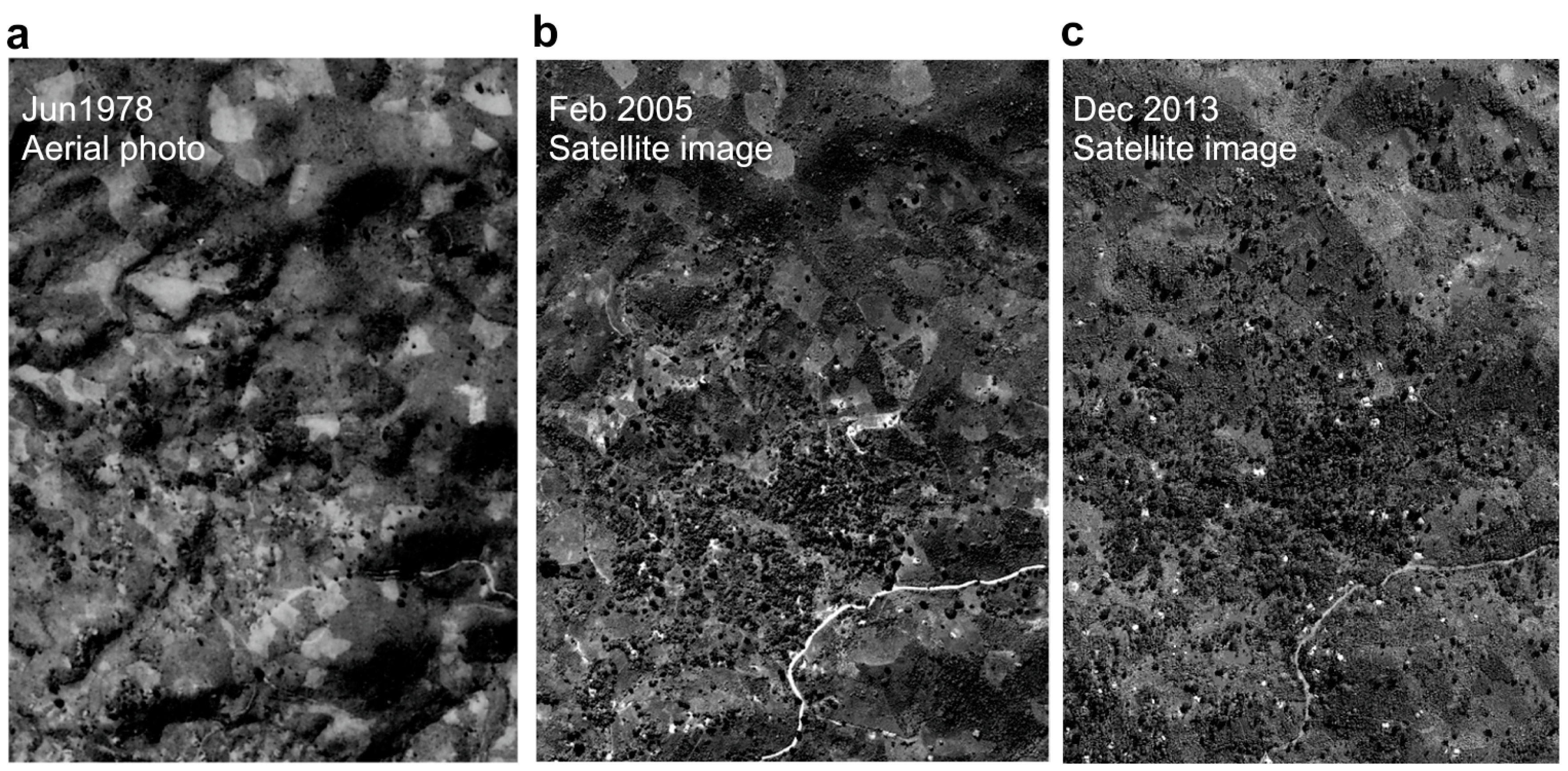
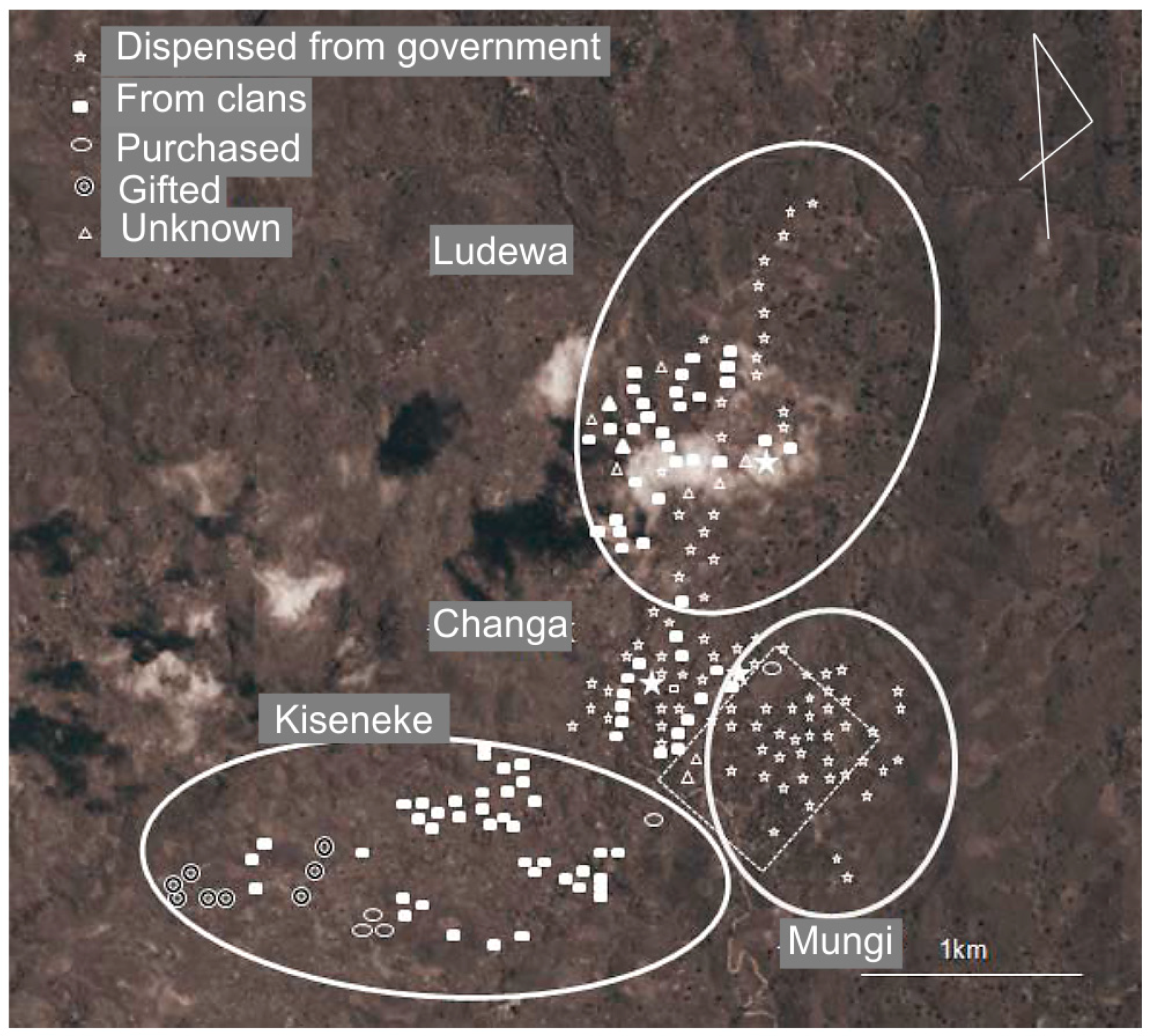
| Household No. | Cropping Pattern | Village District | Altitude | Area | Percentage of cropping Area | Index of DIVERSITy * | Number of Crop Species | (3a) The Percentage of Area Occupied by Tree Crops | Tall Herbaceous Crop | Medium Herbaceous Crops | (3b) The Percentage of Area Occupied by Herbaceous Crops | |||||
|---|---|---|---|---|---|---|---|---|---|---|---|---|---|---|---|---|
| Total | Tree Crops | Herbaceous Crops | Tall Tree | Short Tree | Total | Short Herbaceous Crops | Total | |||||||||
| (m) | (Acre) | (%) | (Spieces) | (Spieces) | (Spieces) | (%) | (%) | (%) | (%) | (%) | (%) | (%) | ||||
| 35 | Type I | Ludewa | 658 | 0.37 | 53.2 | 0.59 | 13 | 6 | 6 | 89.4 | 3.7 | 93.1 | 5.4 | 0.5 | 1.0 | 6.9 |
| 39 | Type I | Ludewa | 658 | 1.00 | 29.5 | 0.77 | 13 | 9 | 4 | 71.2 | 16.8 | 88.0 | 4.5 | 4.0 | 3.5 | 12.0 |
| 27 | Type I | Mungi | 734 | 1.45 | 79.5 | 0.94 | 13 | 10 | 3 | 64.0 | 22.6 | 86.6 | 9.3 | 4.1 | 0.0 | 13.4 |
| 26 | Type I | Mungi | 736 | 1.38 | 54.3 | 0.78 | 13 | 10 | 3 | 80.4 | 3.9 | 84.3 | 11.6 | 1.6 | 2.5 | 15.7 |
| 22 | Type I | Changa | 810 | 0.58 | 73.7 | 0.80 | 16 | 9 | 7 | 66.7 | 14.8 | 81.5 | 13.2 | 5.3 | 0.0 | 18.5 |
| 43 | Type I | Ludewa | 640 | 0.24 | 39.9 | 0.73 | 8 | 6 | 2 | 73.3 | 8.1 | 81.4 | 18.6 | 0.0 | 0.0 | 18.6 |
| 28 | Type I | Mungi | 700 | 0.85 | 85.1 | 0.76 | 13 | 7 | 6 | 56.1 | 23.5 | 79.6 | 8.9 | 2.8 | 8.7 | 20.4 |
| 38 | Type I | Ludewa | 630 | 0.32 | 44.6 | 0.73 | 11 | 7 | 4 | 68.3 | 5.8 | 74.0 | 5.7 | 20.2 | 0.0 | 26.0 |
| 37 | Type I | Ludewa | 664 | 0.99 | 51.8 | 0.67 | 12 | 10 | 2 | 59.5 | 9.9 | 69.4 | 30.6 | 0.0 | 0.0 | 30.6 |
| 31 | Type I | Mungi | 660 | 0.80 | 70.3 | 0.91 | 19 | 11 | 8 | 66.1 | 3.0 | 69.1 | 23.0 | 5.3 | 2.5 | 30.9 |
| 29 | Type I | Mungi | 771 | 0.96 | 78.5 | 0.68 | 9 | 4 | 5 | 15.0 | 49.9 | 64.8 | 1.6 | 20.3 | 13.2 | 35.2 |
| 23 | Type I | Changa | 791 | 0.80 | 58.0 | 0.69 | 11 | 5 | 6 | 60.1 | 1.1 | 61.2 | 25.0 | 9.5 | 4.4 | 38.8 |
| Averadge | 704 | 0.81 | 59.9 | 0.75 | 12.6 | 7.8 | 4.7 | 68.6 | 10.3 | 77.8 | 14.2 | 4.8 | 2.1 | 22.2 | ||
| 42 | Type II | Ludewa | 635 | 0.49 | 78.4 | 0.64 | 8 | 5 | 3 | 19.4 | 36.4 | 55.8 | 7.8 | 0.0 | 36.4 | 44.2 |
| 41 | Type II | Ludewa | 649 | 0.39 | 26.0 | 0.58 | 8 | 5 | 3 | 47.8 | 5.4 | 53.3 | 44.7 | 2.1 | 0.0 | 46.7 |
| 14 | Type II | Kiseneke | 853 | 0.58 | 74.7 | 0.90 | 14 | 9 | 5 | 35.7 | 16.3 | 52.0 | 26.4 | 0.4 | 21.2 | 48.0 |
| 17 | Type II | Kiseneke | 850 | 1.12 | 91.0 | 0.94 | 15 | 9 | 6 | 18.8 | 32.8 | 51.6 | 20.0 | 26.4 | 2.0 | 48.4 |
| 30 | Type II | Mungi | 700 | 0.59 | 61.7 | 0.87 | 13 | 10 | 3 | 30.7 | 20.6 | 51.3 | 17.8 | 30.9 | 0.0 | 48.7 |
| 21 | Type II | Changa | 830 | 1.84 | 47.4 | 0.84 | 11 | 6 | 5 | 37.9 | 13.3 | 51.2 | 10.6 | 4.4 | 33.8 | 48.8 |
| 33 | Type II | Mungi | 660 | 1.13 | 92.9 | 0.94 | 17 | 9 | 8 | 42.9 | 6.9 | 49.9 | 24.9 | 22.9 | 2.4 | 50.1 |
| 32 | Type II | Mungi | 704 | 0.79 | 83.3 | 0.90 | 16 | 7 | 9 | 31.2 | 16.8 | 48.0 | 9.1 | 4.1 | 38.8 | 52.0 |
| 20 | Type II | Kiseneke | 725 | 0.38 | 77.1 | 0.82 | 13 | 6 | 7 | 40.6 | 7.1 | 47.6 | 5.7 | 10.3 | 36.4 | 52.4 |
| 19 | Type II | Kiseneke | 735 | 0.18 | 52.1 | 0.70 | 9 | 5 | 4 | 43.4 | 3.1 | 46.5 | 6.7 | 3.9 | 42.9 | 53.5 |
| 16 | Type II | Kiseneke | 827 | 0.59 | 90.4 | 0.85 | 23 | 9 | 14 | 33.8 | 6.9 | 40.8 | 21.6 | 13.3 | 24.3 | 59.2 |
| Averadge | 743 | 0.74 | 64.7 | 0.82 | 13.4 | 7.3 | 6.1 | 34.8 | 15.0 | 64.9 | 17.7 | 10.8 | 21.7 | 35.1 | ||
| 36 | Type III | Ludewa | 735 | 0.53 | 62.8 | 0.79 | 18 | 10 | 8 | 27.8 | 7.7 | 35.5 | 16.0 | 45.2 | 3.4 | 64.5 |
| 24 | Type III | Mungi | 782 | 0.52 | 67.9 | 0.69 | 11 | 8 | 3 | 16.3 | 16.1 | 32.4 | 0.0 | 2.5 | 65.1 | 67.6 |
| 10 | Type III | Kiseneke | 860 | 0.32 | 48.0 | 0.66 | 13 | 8 | 5 | 14.5 | 13.5 | 28.0 | 12.8 | 57.5 | 1.7 | 72.0 |
| 13 | Type III | Kiseneke | 830 | 0.95 | 89.9 | 0.98 | 24 | 11 | 13 | 19.3 | 8.5 | 27.8 | 35.5 | 14.2 | 22.5 | 72.2 |
| 34 | Type III | Ludewa | 701 | 0.79 | 89.8 | 0.79 | 9 | 4 | 5 | 24.0 | 1.7 | 25.8 | 35.4 | 17.1 | 21.7 | 74.2 |
| 40 | Type III | Ludewa | 649 | 0.70 | 48.1 | 0.58 | 9 | 5 | 4 | 24.2 | 0.8 | 24.9 | 15.5 | 59.6 | 0.0 | 75.1 |
| 15 | Type III | Kiseneke | 838 | 0.53 | 83.6 | 0.85 | 16 | 5 | 11 | 18.5 | 3.2 | 21.7 | 8.1 | 68.4 | 1.8 | 78.3 |
| 11 | Type III | Kiseneke | 860 | 0.34 | 61.8 | 0.72 | 12 | 5 | 7 | 3.0 | 13.9 | 16.9 | 14.0 | 33.2 | 35.9 | 83.1 |
| Averadge | 782 | 0.58 | 69.0 | 0.76 | 14.0 | 7.0 | 7.0 | 18.8 | 7.0 | 26.6 | 19.6 | 42.2 | 12.4 | 73.4 | ||
| 8 | Type IV | Kiseneke | 902 | 0.43 | 75.6 | 0.84 | 16 | 6 | 10 | 5.9 | 8.7 | 14.6 | 16.4 | 35.1 | 33.9 | 85.4 |
| 2 | Type IV | Kiseneke | 1175 | 0.54 | 88.1 | 0.54 | 10 | 4 | 6 | 9.3 | 0.9 | 10.3 | 43.8 | 3.7 | 42.3 | 89.7 |
| 9 | Type IV | Kiseneke | 910 | 0.38 | 93.2 | 0.68 | 14 | 6 | 8 | 7.4 | 1.7 | 9.1 | 14.6 | 37.0 | 39.3 | 90.9 |
| 1 | Type IV | Kiseneke | 1222 | 0.70 | 80.3 | 0.73 | 7 | 2 | 5 | 4.4 | 2.3 | 6.7 | 21.3 | 41.7 | 30.2 | 93.3 |
| 12 | Type IV | Kiseneke | 852 | 1.23 | 37.7 | 0.65 | 13 | 6 | 7 | 4.6 | 1.7 | 6.3 | 33.2 | 29.9 | 30.6 | 93.7 |
| 7 | Type IV | Kiseneke | 920 | 0.53 | 88.8 | 0.58 | 10 | 2 | 8 | 2.6 | 3.7 | 6.3 | 15.0 | 38.7 | 40.1 | 93.7 |
| 4 | Type IV | Kiseneke | 1109 | 0.44 | 69.3 | 0.78 | 14 | 1 | 13 | 0.0 | 0.3 | 0.3 | 32.9 | 31.7 | 35.1 | 99.7 |
| Averadge | 1013 | 0.6 | 76.1 | 0.69 | 12.0 | 3.9 | 8.1 | 4.6 | 2.2 | 7.7 | 24.7 | 32.1 | 36.4 | 92.3 | ||
| 25 | Type V | Mungi | 800 | 0.44 | 84.6 | 0.46 | 12 | 6 | 6 | 4.2 | 61.9 | 66.1 | 0.9 | 31.9 | 1.1 | 33.9 |
| 5 | Type V | Kiseneke | 950 | 0.21 | 65.6 | 0.48 | 6 | 2 | 4 | 7.3 | 0.5 | 7.8 | 20.8 | 63.3 | 8.1 | 92.2 |
| 6 | Type V | Kiseneke | 944 | 0.15 | 76.4 | 0.48 | 10 | 5 | 5 | 4.3 | 3.4 | 7.7 | 5.1 | 85.4 | 1.8 | 92.3 |
| 3 | Type V | Kiseneke | 1170 | 0.74 | 71.7 | 0.40 | 6 | 0 | 5 | 0.0 | 0.0 | 0.0 | 24.4 | 7.9 | 67.7 | 100.0 |
| 18 | Type V | Kiseneke | 736 | 0.17 | 82.9 | 0.29 | 3 | 0 | 3 | 0.0 | 0.0 | 0.0 | 7.5 | 13.9 | 78.6 | 100.0 |
| Average | 905 | 0.54 | 76.2 | 0.42 | 11.5 | 4.6 | 6.8 | 7.9 | 26.3 | 16.3 | 3.0 | 30.8 | 32.0 | 83.7 | ||
| Tree Form-Plant Type | Species Number | English | Local Name | Species | Average Height | Max | Number Measured | Percentage Measured | Total Observed |
|---|---|---|---|---|---|---|---|---|---|
| (m) | (m) | (Number) | (%) | (Number) | |||||
| Tall trees | 1 | Coco palm | Minazi | Cocos nucifera L. | 14.1 | 25.0 | 90 | 32.7 | 275 |
| More than 15 m | 2 | Bread Fruit | Msherisheli | Treculia africana Decne. | 13.6 | 19.0 | 64 | 59.3 | 108 |
| 3 | Jack Fruit | Fenesi | Artocarpus heterophyllus Lam. | 11.8 | 20.0 | 75 | 66.4 | 113 | |
| 4 | - | Mwembe ng’ong’o | Sclerocarya birrea (A. Rich.) Hochst. | 14.6 | 19.4 | 16 | 88.9 | 18 | |
| 5 | Eucalyptus | Maidini | Eucalyptus sp. | 15.3 | 23.0 | 16 | 88.9 | 18 | |
| 6 | East African mahogany | Mkanbazi | Khaya anthotheca (Welw.) C.DC. | 13.2 | 25.0 | 22 | 44.9 | 49 | |
| 7 | Kapok | Msufi | Ceiba pentandra (L.) Gaertn. | 13.5 | 22.0 | 4 | 80.0 | 5 | |
| 8 | Durian | Mduriani | Durio zibethinus L. | 20.0 | 20.0 | 1 | 100.0 | 1 | |
| 9 | Jambolan | Mzambarawe | Syzygium cuminii L. | 16.0 | 16.0 | 1 | 25.0 | 4 | |
| Short trees | 11 | African Oil Palm | Chikichi | Elaeis guineensis Jacq. | 8.0 | 8.0 | 1 | 50.0 | 2 |
| Less than 10 m | 12 | Avocado | Mfukado | Persea americana Mill. | 8.1 | 8.0 | 15 | 36.6 | 41 |
| 13 | Mango | Mihembe | Mangifera indica L. | 5.0 | 23.0 | 2 | 100.0 | 2 | |
| 14 | Clove | Amdarasini | Syzygium aromaticum (L.) Merrill & Perry | 5.6 | 12.0 | 49 | 32.0 | 153 | |
| 15 | Cinnamon | Amdarasini | Cinnamomum zeylanicum J.Presl | 3.4 | 8.0 | 45 | 4.5 | 997 | |
| 16 | Coffee | Buni | Coffea arabica/robusta L. | 3.1 | 8.0 | 23 | 12.0 | 192 | |
| 17 | Tree cassava | Chisamvu | Manihot sp. | 1.8 | 2.0 | 3 | 25.0 | 12 | |
| 18 | Bamboo | Mlanzi | Bambusoideae spp. | 3.0 | 3.0 | 7 | - | ||
| 19 | Orange | Mchenza | Citrus reticulata Blanco, 1837 | 2.9 | 8.0 | 14 | 70.0 | 20 | |
| 20 | Papaya | Papai | Carica papaya L. | 2.0 | 2.0 | 6 | 37.5 | 16 | |
| 21 | Soursop | Stafeli | Annona muricata L. | 4.0 | 5.0 | 3 | 75.0 | 4 | |
| 22 | - | Mkaranga mti | Bombax rhodognaphalon A.Robyns | 2.3 | 3.0 | 2 | 50.0 | 4 | |
| 23 | - | Kitupa | Tephrosia vogelii Hook.f. | 1.7 | 2.0 | 3 | 30.0 | 10 |
| Tree Form-Plant Type | Number of Species | English | Local Name | Species | |
|---|---|---|---|---|---|
| Tall herbaceous crops | More than 5 m | 1 | Banana | Makowo | Musa spp. |
| 2 | Black pepper | Pilipili mtama | Piper nigrum L. | ||
| 3 | Oyster nuts | Mkweme | Telfairia occidentalis Hook.f. | ||
| Medium herbaceous crops | 1–5 m | 4 | Cardamom | Iliki | Elettaria cardamomun (L.) Maton |
| 5 | Coco yam | Ghimbi | Colocasia esculenta (L.) Schott/Xanthosoma sagittifolium | ||
| 6 | Cassava | Gumuhogo | Manihot esculenta Crantz | ||
| 7 | Castor oil plant | Mnyemba | Ricinus communis L | ||
| 8 | Hyacinth bean | Fyifyi | Lablab niger (L.) Sweet | ||
| 9 | Night shade | Diderega | Basella alba L. | ||
| 10 | Maize | Ditama | Zea mays L. | ||
| 11 | Okra | Dibamia | Abelmoschus esculentus (L.) Moench | ||
| 12 | Passion fruits | Matunda kweme | Passiflora edulis Sims, 1818 | ||
| 13 | Pigeon pea | Zimange | Cajanus cajan L. | ||
| 14 | Sisal | Mkonge | Agave sisalana Perrine | ||
| 15 | Scarlet runner | Kikamba | Phaseolus coccineus L. | ||
| 16 | Sugarcane | Mguwa | Saccharum officinarum L. | ||
| 17 | Yam | Vigonzo | Dioscorea alata L. | ||
| Short herbaceous crops | Less than 1 m | 18 | Amaranths | Gumchicha | Amaranthus spp. |
| 19 | Basil | Not sure | Ocimum basilicum L. | ||
| 20 | Bitter tomato | Zinungwi | Solanum spp. | ||
| 21 | Chili | Pilipili | Capsicum frutescens L. Capsicum chinense Jacq. Capsicum annuum L. | ||
| 22 | Ginger | Mbwiga | Zingiber officinale Roscoe | ||
| 23 | Kidney beans | Maharagi | Phaseolus vulgaris L. | ||
| 24 | Pineapple | Dinanasi | Ananas comosus (L.) Merr. | ||
| 25 | Rice | Uhunga | Oryza sativa L. | ||
| 26 | Roselle | Damudamu | Hibiscus subdariffa L. | ||
| 27 | Sweet potato | Tenbere | Ipomoea batatas (L.) Lam. | ||
| 28 | Tomato | Nyanya | Lycopersicon esculentum L. | ||
| 29 | Vanilla | Not sure | Vanilla planifolia Jacks. ex Andrews |
© 2018 by the authors. Licensee MDPI, Basel, Switzerland. This article is an open access article distributed under the terms and conditions of the Creative Commons Attribution (CC BY) license (http://creativecommons.org/licenses/by/4.0/).
Share and Cite
Yamane, Y.; Kularatne, J.; Ito, K. Diversity of Cropping Patterns and Factors Affecting Homegarden Cultivation in Kiboguwa on the Eastern Slopes of the Uluguru Mountains in Tanzania. Agriculture 2018, 8, 141. https://doi.org/10.3390/agriculture8090141
Yamane Y, Kularatne J, Ito K. Diversity of Cropping Patterns and Factors Affecting Homegarden Cultivation in Kiboguwa on the Eastern Slopes of the Uluguru Mountains in Tanzania. Agriculture. 2018; 8(9):141. https://doi.org/10.3390/agriculture8090141
Chicago/Turabian StyleYamane, Yuko, Jagath Kularatne, and Kasumi Ito. 2018. "Diversity of Cropping Patterns and Factors Affecting Homegarden Cultivation in Kiboguwa on the Eastern Slopes of the Uluguru Mountains in Tanzania" Agriculture 8, no. 9: 141. https://doi.org/10.3390/agriculture8090141
APA StyleYamane, Y., Kularatne, J., & Ito, K. (2018). Diversity of Cropping Patterns and Factors Affecting Homegarden Cultivation in Kiboguwa on the Eastern Slopes of the Uluguru Mountains in Tanzania. Agriculture, 8(9), 141. https://doi.org/10.3390/agriculture8090141





